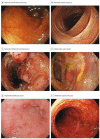Inflammatory Bowel Disease in Children and Adolescents
- PMID: 26414706
- PMCID: PMC4702263
- DOI: 10.1001/jamapediatrics.2015.1982
Inflammatory Bowel Disease in Children and Adolescents
Abstract
The inflammatory bowel diseases (IBDs), including ulcerative colitis and Crohn disease, are chronic inflammatory disorders of the gastrointestinal tract most often diagnosed in adolescence and young adulthood, with a rising incidence in pediatric populations. These disorders are common enough in children that most pediatricians and other pediatric clinicians will encounter children with IBD in their general practice. Inflammatory bowel disease is caused by a dysregulated mucosal immune response to the intestinal microflora in genetically predisposed hosts. Although children can present with the classic symptoms of weight loss, abdominal pain, and bloody diarrhea, many present with nonclassic symptoms of isolated poor growth, anemia, or other extraintestinal manifestations. Once IBD is diagnosed, the goals of therapy consist of eliminating symptoms, normalizing quality of life, restoring growth, and preventing complications while minimizing the adverse effects of medications. Unique considerations when treating children and adolescents with IBD include attention to the effects of the disease on growth and development, bone health, and psychosocial functioning. The purpose of this review is to provide a contemporary overview of the epidemiologic features, pathogenesis, diagnosis, and management of IBD in children and adolescents.
Figures

References
-
- Baldassano RN, Piccoli DA. Inflammatory bowel disease in pediatric and adolescent patients. Gastroenterol Clin North Am. 1999;28(2):445–458. - PubMed
-
- Abramson O, Durant M, Mow W, et al. Incidence, prevalence, and time trends of pediatric inflammatory bowel disease in Northern California, 1996 to 2006. J Pediatr. 2010;157(2):233–239.e1. doi:10.1016/j.jpeds.2010.02.024. - PubMed
-
- Benchimol EI, Fortinsky KJ, Gozdyra P, Van den Heuvel M, Van Limbergen J, Griffiths AM. Epidemiology of pediatric inflammatory bowel disease: a systematic review of international trends. Inflamm Bowel Dis. 2011;17(1):423–439. - PubMed
Publication types
MeSH terms
Grants and funding
LinkOut - more resources
Full Text Sources
Other Literature Sources
Medical

